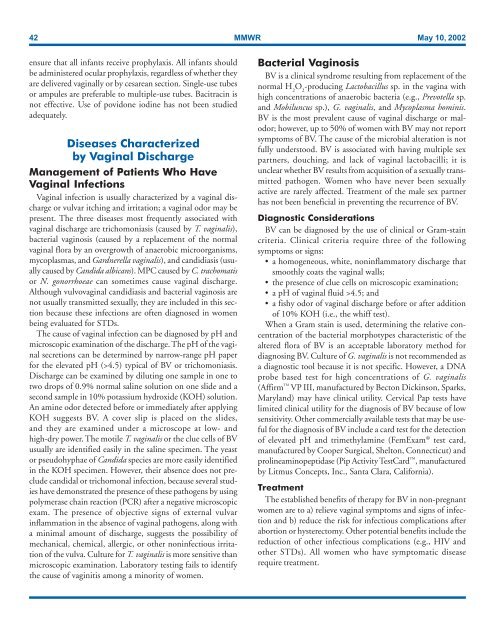Create successful ePaper yourself
Turn your PDF publications into a flip-book with our unique Google optimized e-Paper software.
42 MMWR May 10, 2002<br />
ensure that all infants receive prophylaxis. All infants should<br />
be administered ocular prophylaxis, regardless of whether they<br />
are delivered vaginally or by cesarean section. Single-use tubes<br />
or ampules are preferable to multiple-use tubes. Bacitracin is<br />
not effective. Use of povidone iodine has not been studied<br />
adequately.<br />
Diseases Characterized<br />
by Vaginal Discharge<br />
Management of Patients Who Have<br />
Vaginal Infections<br />
Vaginal infection is usually characterized by a vaginal discharge<br />
or vulvar itching and irritation; a vaginal odor may be<br />
present. The three diseases most frequently associated with<br />
vaginal discharge are trichomoniasis (caused by T. vaginalis),<br />
bacterial vaginosis (caused by a replacement of the normal<br />
vaginal flora by an overgrowth of anaerobic microorganisms,<br />
mycoplasmas, and Gardnerella vaginalis), and candidiasis (usually<br />
caused by Candida albicans). MPC caused by C. trachomatis<br />
or N. gonorrhoeae can sometimes cause vaginal discharge.<br />
Although vulvovaginal candidiasis and bacterial vaginosis are<br />
not usually transmitted sexually, they are included in this section<br />
because these infections are often diagnosed in women<br />
being evaluated for STDs.<br />
The cause of vaginal infection can be diagnosed by pH and<br />
microscopic examination of the discharge. The pH of the vaginal<br />
secretions can be determined by narrow-range pH paper<br />
for the elevated pH (>4.5) typical of BV or trichomoniasis.<br />
Discharge can be examined by diluting one sample in one to<br />
two drops of 0.9% normal saline solution on one slide and a<br />
second sample in 10% potassium hydroxide (KOH) solution.<br />
An amine odor detected before or immediately after applying<br />
KOH suggests BV. A cover slip is placed on the slides,<br />
and they are examined under a microscope at low- and<br />
high-dry power. The motile T. vaginalis or the clue cells of BV<br />
usually are identified easily in the saline specimen. The yeast<br />
or pseudohyphae of Candida species are more easily identified<br />
in the KOH specimen. However, their absence does not preclude<br />
candidal or trichomonal infection, because several studies<br />
have demonstrated the presence of these pathogens by using<br />
polymerase chain reaction (PCR) after a negative microscopic<br />
exam. The presence of objective signs of external vulvar<br />
inflammation in the absence of vaginal pathogens, along with<br />
a minimal amount of discharge, suggests the possibility of<br />
mechanical, chemical, allergic, or other noninfectious irritation<br />
of the vulva. Culture for T. vaginalis is more sensitive than<br />
microscopic examination. Laboratory testing fails to identify<br />
the cause of vaginitis among a minority of women.<br />
Bacterial Vaginosis<br />
BV is a clinical syndrome resulting from replacement of the<br />
normal H 2 O 2 -producing Lactobacillus sp. in the vagina with<br />
high concentrations of anaerobic bacteria (e.g., Prevotella sp.<br />
and Mobiluncus sp.), G. vaginalis, and Mycoplasma hominis.<br />
BV is the most prevalent cause of vaginal discharge or malodor;<br />
however, up to 50% of women with BV may not report<br />
symptoms of BV. The cause of the microbial alteration is not<br />
fully understood. BV is associated with having multiple sex<br />
partners, douching, and lack of vaginal lactobacilli; it is<br />
unclear whether BV results from acquisition of a sexually transmitted<br />
pathogen. Women who have never been sexually<br />
active are rarely affected. Treatment of the male sex partner<br />
has not been beneficial in preventing the recurrence of BV.<br />
Diagnostic Considerations<br />
BV can be diagnosed by the use of clinical or Gram-stain<br />
criteria. Clinical criteria require three of the following<br />
symptoms or signs:<br />
a homogeneous, white, noninflammatory discharge that<br />
smoothly coats the vaginal walls;<br />
the presence of clue cells on microscopic examination;<br />
a pH of vaginal fluid >4.5; and<br />
a fishy odor of vaginal discharge before or after addition<br />
of 10% KOH (i.e., the whiff test).<br />
When a Gram stain is used, determining the relative concentration<br />
of the bacterial morphotypes characteristic of the<br />
altered flora of BV is an acceptable laboratory method for<br />
diagnosing BV. Culture of G. vaginalis is not recommended as<br />
a diagnostic tool because it is not specific. However, a DNA<br />
probe based test for high concentrations of G. vaginalis<br />
(Affirm VP III, manufactured by Becton Dickinson, Sparks,<br />
Maryland) may have clinical utility. Cervical Pap tests have<br />
limited clinical utility for the diagnosis of BV because of low<br />
sensitivity. Other commercially available tests that may be useful<br />
for the diagnosis of BV include a card test for the detection<br />
of elevated pH and trimethylamine (FemExam ® test card,<br />
manufactured by Cooper Surgical, Shelton, Connecticut) and<br />
prolineaminopeptidase (Pip Activity TestCard , manufactured<br />
by Litmus Concepts, Inc., Santa Clara, California).<br />
Treatment<br />
The established benefits of therapy for BV in non-pregnant<br />
women are to a) relieve vaginal symptoms and signs of infection<br />
and b) reduce the risk for infectious complications after<br />
abortion or hysterectomy. Other potential benefits include the<br />
reduction of other infectious complications (e.g., HIV and<br />
other STDs). All women who have symptomatic disease<br />
require treatment.


